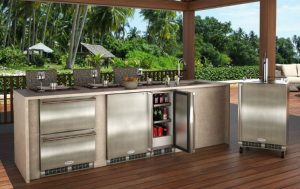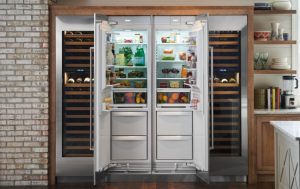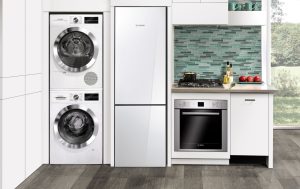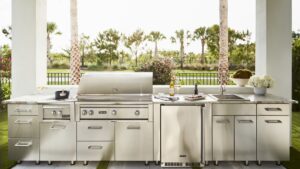10 Tips to Run a Refrigerator in a Hot Garage Space
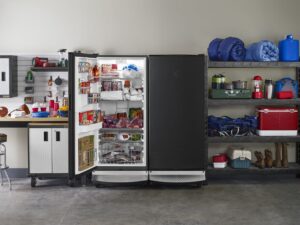
Those that enjoy outdoor entertaining or have teens that they don’t want to have coming in and out throughout the day may benefit from a second refrigerator in the garage. This is an excellent plant to store cold drinks for kids and adults, and food that’s destined for the grill. It’s also a handy location for any extra food items that cannot be accommodated in the kitchen refrigerator too. The only real drawback is the warmer summer weather which can turn the garage into a hot and humid environment. If you don’t have a climate controlled garage this can introduce a lot of stress on the garage refrigerator. In this article, we will look at ten tried and tested tips to run your refrigerator in these hotter conditions.
1. Fill the Refrigerator to Capacity
Some people believe that a fuller refrigerator places the appliance under additional strain. In reality, the exact opposite is true, when a refrigerator is fuller it will work far more efficiently at any time of the year.
An emptier refrigerator has more space where warm air can enter and this needs to be cooled down reducing the efficiency. Remember that the refrigerator door will be opened multiple times each day and warmer air can enter the space. If you don’t need all the refrigerator space, it’s a great idea to fill it up with bottles of water to keep it closer to full capacity.
2. Check the Power Hookup
A modern kitchen should be designed to accommodate kitchen appliances and this includes the power requirements. But, a garage may not have the proper electrical hookup to ensure that the refrigerator is receiving sufficient power.
This places the appliance under stress because it may struggle to cool in a hot location. A refrigerator requires 60Hz AC with a 115v electrical outlet. If you’re not sure that you’ve got the proper wiring and power outlet, consult a local electrician.
3. Cool the Space
When the internal garage temperature routinely exceeds 110ºF, it’s unlikely that the refrigerator will operate as intended. In fact, the appliance may even fail or burn out entirely, because it’s working too hard. The refrigerator will be constantly working to compensate for the high ambient temperatures during the day.
The best solution to this problem is to find a way to cool the garage and there are a number of options. Installing vents or fans, adding passive insulation or even using a supplemental AC system can all help. If the temperature spikes are short-term problems it may be possible to lower the temperature with window coverings to keep the sunlight out.
4. Protect Perishables
During periods of extreme heat, the refrigerator may be under an increased risk of failure. This risk is exacerbated because the appliance is kept in an out of the way location. Infrequent visitors to the garage may fail to notice the problem until it’s too late. So, even if you have the aforementioned precautionary measures in place, it may be a good idea to protect perishable food items.
The garage refrigerator can be stocked with sodas, beers and bottles of water throughout the summer because there’s no risk of spoilage. But, meat, ice cream and other perishable items should be transferred to the main kitchen refrigerator. This will reduce the risk of food wastage and avoid the hassle of a cleanup in the event of a garage refrigerator failure.
5. Clear the Clutter
The humidity and temperature swings in a garage can affect the operation and efficiency of your refrigerator. But, there are other risks to consider and a cluttered garage is not a great place to keep your appliance.
Many of us are avid DIY enthusiasts, we may have tools, fluids, sharp objects, grime and sawdust all over the garage. These can be a considerable trip risk, but the grimy dust can also accumulate on the refrigerator coils.
The best way to improve the space is to clean it thoroughly and organize the contents into boxes. This will improve the airflow and reduce the levels of airborne contaminants that can affect the coils. This simple tip alone can drastically improve the performance and energy efficiency of your appliance.
6. Consider Maintenance
Many homeowners will buy their refrigerator, run it for a few years until it’s out of warranty and then buy a new model when it fails. But, there are some basic maintenance tasks that can extend the useful lifespan and improve efficiency. A prime example is the coils that are prone to collecting a layer of dirt, dust and other debris. If the coils are carefully vacuumed on a semi-regular basis, the refrigerator is less likely to fail when you need it most.
7. Build a Conditioned Space
It may be impractical to add an AC system to the entire garage space to keep the air temperature at a more acceptable level. This process could involve extensive retro-fitting that’s likely to be cost prohibitive for many homeowners. But, it may be possible to create a smaller space within the garage where it’s easier to control the environment.
Some homeowners create an enclosed frame around their refrigerator that separates it from the garage. This smaller area can be cooled with a small-scale AC system, a fan, vents or with extra layers of passive insulation. The temperature will change when the refrigerator is accessed, but it will return to normal quickly if the secondary door is not left open for too long.
8. Refrigerator Heaters
Although we’re covering periods of heat in the garage, it’s a good idea to know how you’re going to deal with cold too. If the garage temperature drops below freezing, the refrigerator thermostat can be fooled into shutting off because the external temperature is “cold enough”. So, it may be necessary to add some heating or a heat coil on the thermostat to keep the appliance working.
Certain manufacturers sell these components as an aftermarket accessory or there are generic models on the market. A simple solution is to add a metal work lamp clamp next to the refrigerator with an incandescent light bulb. This can be targeted at the thermostat sensor to add a little heat and keep the refrigerator working. The exact position of the sensor will vary depending on the make and model and it should be detailed in the owner’s manual.
9. Understand Your Local Climate
Those that spend most of their time indoors enjoying an air conditioned environment may be less aware of their local climate conditions than others. Every locality has its own challenges to overcome and this will affect a refrigerator kept in your garage.
A garage refrigerator in Louisiana may be more prone to rust and in Arizona there will be fewer problems related to humidity. Understanding your local climate can help you to identify potential threats and take measures to mitigate the risks. This will keep your refrigerator running at peak efficiency for longer.
10. Garage Refrigerators
If you have a refrigerator that doesn’t fare well in a garage and none of the options above will help, it’s time to explore other options. Traditionally, the older kitchen refrigerator would be moved into the garage when a newer model was purchased and installed. But, there are now new refrigerator models that are optimized for a garage installation. These refrigerators and freezers are often referred to as “garage-ready”.
These appliances are designed to handle humidity, heat and cold that may present problems for standard refrigerators. This may remove some or all of the requirements to make the garage a more optimized location for a refrigerator. But, certain models are designed to deal with extreme heat and vice versa. So, it’s important to understand your needs before you make a final purchasing decision. All “garage-ready” appliances do come at a premium, but the extra cost may be worth it when you consider the alternatives.
In Conclusion
There are three possible options when you’re thinking about a garage refrigerator. First, you could do what your parents probably did, buy a new appliance for your kitchen and move the older model into the garage. The second option is to buy the aforementioned “garage-ready” refrigerator type and install that in your garage. The final option is to use the tips and tricks in this article to keep a standard refrigerator working in your garage. But, when you consider some of the costs it may be a better financial decision to go with the “garage-ready” refrigerator that has the higher ticket price.
Understanding how the refrigerator works can help you to make the right choice. All modern fridges compare the internal compartment temperature to the external environment. Then a temperature adjustment is made to meet the thermostat setting and excess cold air is directed from the freezer to the refrigerator. This is a balancing act that’s hard to maintain in a garage with no cooling or heating system. This can drive up the energy bills if no steps are taken to lower the costs with passive insulation.
If you’re thinking about a new refrigerator for your garage, explore your options with our online collection. If you require a specialized service, you can speak to one of our home appliance experts.
- Designing the Ultimate Outdoor Bar: Must-Have Appliances for Year-Round Fun
- Luxury Refrigerator Guide 2025: Built-In vs. Freestanding and What to Know Before You Buy
- How Smart Appliances Are Changing Luxury Kitchen Design in 2025
- The Ultimate Outdoor Grill Guide for 2025: Built-In vs. Freestanding
- Smart Bathroom Faucets & Fixtures in 2025: Blending Technology with Luxury Design
- Built-In Coffee Machines: Are They Worth It for Your Kitchen in 2025?
- How to Choose the Right Dishwasher for Your Home: Noise, Capacity, and Features Explained
- Top 5 Kitchen Appliance Colors and Finishes for 2025 (And How to Match Your Style)
- Why a Countertop Ice Maker is a Must-Have for Summer Kitchen Upgrades in Southern California
- How to Remove Scratches from Stainless Steel Luxury Appliances


